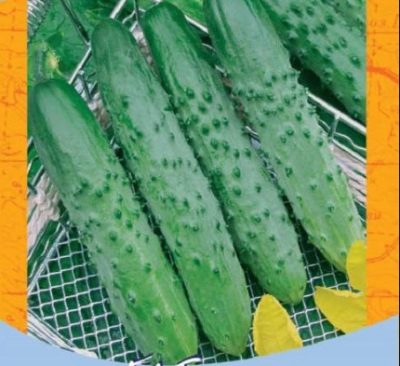
- Authors: Gavrish S.F., Portyankin A.E., Shamshina A.V., Prutenskaya N.A.
- Year of approval: 2006
- Growth type: indeterminate
- Branching: the average
- Fruit weight, g: 126-138
- Fruit length, cm: 20-22
- Fruit color: green with short or medium stripes
- Ripening terms: average
- Pollination: bee-pollinated
- Fruit shape: cylindrical
For growing in the winter-spring period, a hybrid variety called Bax is perfect. A distinctive characteristic of this culture is the large size of the fruits, therefore it belongs to the salad varieties.
Description of the variety
The bred hybrid can be grown in any conditions (open areas, winter and film greenhouses). This variety was obtained thanks to the efforts of professional breeders. To form a crop, insect pollination is needed. The color of the petals is bright yellow. Some summer residents grow vegetables on the balcony or loggia.
Characteristics of the appearance of plants and zelents
The main stem reaches a height of 300-350 centimeters. Branching is medium, and the type of growth is indeterminate. Small leaves are colored deep green and cover the shoots in abundance. One node grows from 1 to 3 female flowers. As it grows, an average shoot-forming ability is observed.
Cucumbers grow up to 20-22 centimeters, this length is considered average. In diameter, they reach from 4 to 4.5 centimeters. Weight varies from 126 to 138 grams. The shape of the vegetables is cylindrical, which is typical for most cucumber varieties. The skin is green in color, covered with expressive stripes, medium or short in length. The surface is lumpy, but the tubercles are rare. White thorns are also visible on the peel.
Purpose and taste of fruits
The taste qualities of Bucks cucumbers are high. When eaten, sweetish notes and freshness are felt. When grown properly, it forms a juicy, tender and crunchy flesh. And also there are no emptiness and bitterness. This crop is in great demand among professional farmers and amateur gardeners. Due to its pleasant texture and expressive taste, this variety is often chosen by buyers.
Fresh fruits are recommended to be used for making salads, or to enjoy their natural taste. They are also suitable for salting.
Maturation
Bax cucumber belongs to crops with medium ripening periods. From the moment the first shoots appear and until fruiting, 68 days should pass. Harvesting is recommended as it ripens. It is impossible to overripe the fruits, as this negatively affects their gastronomic qualities. Bitterness appears in cucumbers, and bushes lose their ability to form new ovaries. It is advisable to carry out the work every day or after 2 days, depending on the fruiting and ripening rate of the crop.
Yield
The high yield was noted by all gardeners who personally cultivated the Baks hybrid variety. The average figure is from 18.4 to 33.3 kilograms per square meter of land. At the same time, the marketability is 85%.
To keep the vegetables as long as possible, after harvesting, the cucumber boxes are transferred to a cool room. The air temperature should not exceed 4 degrees Celsius. For storage, you need to prepare a container with holes in advance so as not to interfere with airing. If the cucumbers do not get enough oxygen, rotting will begin.
Landing scheme
The recommended planting scheme for this fruit crop is 50x70 centimeters.
Growing and care
Only warm water is used for irrigation, since plants do not react well to cold liquid. Defend water for at least 24 hours. Water is poured in carefully so that it falls only on the soil, bypassing the stem, shoots and leaves. Irrigation is performed every two days, but if dry and hot weather is established outside the window, irrigation is carried out as needed. The soil should not be waterlogged or dry.
Fruit crops need constant fertilization. Nutrient formulations are applied every 10 days. During the cultivation season, about 5 dressings are performed. Experienced summer residents are advised to pay attention to complex formulations, the basis of which is dung or manure.
And also the hybrid reacts well to minerals such as superphosphate, potassium salt or ammonium nitrate.
For greater efficiency, it is advisable to combine hilling together with watering the beds. Work is advised to be carried out every 10 days. This agrotechnical procedure is necessary to remove rough crust from the surface of the earth. It prevents the penetration of water and oxygen to the root system.
Another important condition when caring for cucumber bushes is the formation and tying of plants. The main stem is neatly fixed to the trellis, fixing it with a strong and thick rope. You can also use strips of fabric. Do not fasten the vine with wire, as it can damage the shoots.
In the process of tying, you need to ensure that the main shoot is not overtightened, otherwise it becomes weak and lethargic. The fruits no longer receive the required amount of minerals.
For planting, you should choose a sunny area, while the hybrid has increased shade tolerance.

In order to collect strong, tasty and beautiful cucumbers on your site, you need to make top dressing. Lack of nutrients can negatively affect the appearance of the plant and significantly reduce the yield. Fertilize cucumbers with organic fertilizers in combination with mineral fertilizers. With the right balance of these components and adherence to the fertilizing schedule, the cucumber yield will be maximum.

Despite their popularity, cucumbers are often attacked by diseases and pests. From them, cucumber plantings often die before the start of fruiting. In order to prevent this from happening, it is necessary to try to prevent ailments or get rid of them at the very beginning, having studied in detail their causes of occurrence, signs and methods of treatment.





























































































